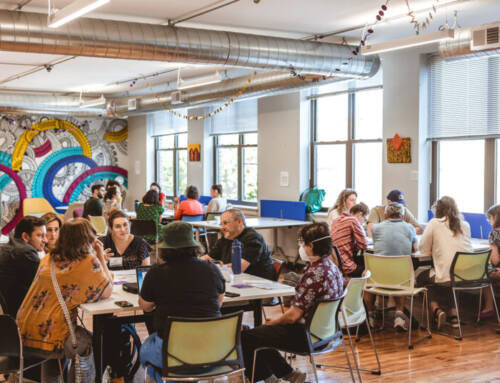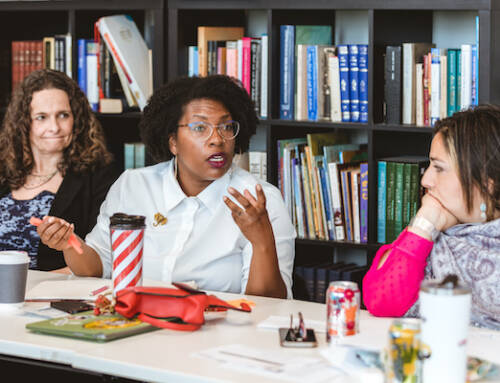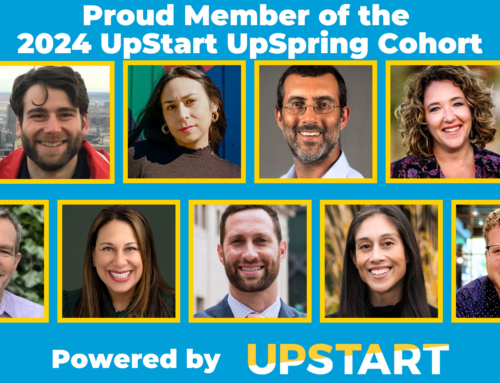May 30, 2017 | eJewish Philanthropy
By Maya Bernstein, UpStart Associate
We are approaching the holiday of Shavuot, a time of re-commitment to keeping the Torah meaningful and relevant to our lives. There is a curious phrase in Exodus 20:14, which we read on the holiday to commemorate the Israelite’s experience of receiving the Torah at Sinai. The Torah sets the scene: the people stand trembling at the foot of the mountain; Moses is at the top with God, the elders are partway up the mountain, and the sky is bursting with lightening, the air alive with thunder. “All of the people,” the Torah says, “see the sounds – roim et hakolot.” What could this mean?
Rashi, the 11th Century commentator, explains that they saw what was usually heard. Perhaps they visualized each of the commandments as they were spoken, as if they were watching a film? The Sefat Emet offers a profound insight into this confusing expression. He explains the fundamental difference between seeing and hearing:
“In hearing there is the quality of the sound entering one’s very being, through the ear. But sight is external. And though the sound entered them entirely, they were still able to see it, as if it were external.”
The people were somehow able to take something that is normally internal – normally not seen or noticed or paid attention to – and were able to see it with perspective and connect to it. At this point in the Jewish people’s history, they were, in 21st century terms, receiving a new design. They were being introduced to a system of laws and rituals and practices that would radically shift their lives, turning them from a slave people into the Jewish people. In order for it to be effective, the people needed to internalize it. But they could not internalize it without first understanding it, making sense of it before it became a part of them.
Perhaps they were able to have a clear understanding of this impending disruptive innovation because the Sinai experience comes in the middle of their liminal desert experience. The desert-time can be interpreted as an iterative, choreographed process of taking this new way of thinking and being and helping the people internalize it, make it their own, and become part of their way of functioning. We focus on the innovation – on the Sinai experience itself – but what allowed the people to simultaneously see (understand) and hear (internalize & accept) that experience was the process.
The hard work of innovation is not necessarily in the introduction and support of great new ideas. Often, it is the unglamorous work of tilling the soil to allow those ideas to thrive. It is the political work of partnering, communicating, and building trust, so that the new ideas can become part of the fabric of the establishment, and the system as a whole can thrive. In their HBR article “Design for Action,” Tim Brown and Roger Martin discuss the evolution of Design Thinking, a now well-known methodology to increase the generation of innovative ideas. It began as a process focused solely on the innovative design of physical objects, then advanced to the design of innovative products, specifically technological tools, and now includes the design of processes and strategy. They write, “Each design process is more complicated and sophisticated than the one before … each is enabled by learning from the preceding stage.”
The Design Thinking process is now being used for more complex, systemic, intangible challenges. Precisely because Design Thinking introduces radical ways of thinking and working into organizations, it is often met with resistance and suspicion – which was not the case when it was being used simply to design more comfortable office chairs (who doesn’t want a better chair?). The challenge, therefore, is the acceptance of the new design by the organization into which the design is being introduced:
As the complexity of the design process increases, a new hurdle arises: the acceptance of what we might call the ‘designed artifact’ – whether product, user experience, strategy, or complex system – by stakeholders … that means the introduction of the new artifact requires design attention as well.
If we truly want to create a Jewish community that has offerings that are more relevant and inspiring for community members, we must be thoughtful and deliberate about how we introduce those new ideas into the community, and how we build partnerships, trust, and relationships between the various segments of the community to allow for the innovative ideas and programs to exist. As Brown and Martin write, “intervention is a multistep process – consisting of many small steps.”
Perhaps that is why the holiday is called Shavuot – which means weeks. When we celebrate the receiving of the Torah, we are truly celebrating the process – the many weeks – involved in setting the stage for the people to be able to internalize the Torah. We count each day between Passover and Shavuot, and we celebrate only upon the culmination of the count-down. This is consistent with Brown and Martin’s noting that the “launch of the new design ceases to be the focus. Rather, it is just one step somewhere in the middle of a carefully designed intervention.”
As we approach this holiday, individually and communally growing in our relationship to this tradition, pursuing those new ways of thinking and working that allow us to keep it relevant and vibrant, we would benefit from “seeing the sounds” – from heeding Brown and Martin’s advice, experimenting with our new ideas in an evolution of small steps, deliberately designing the internal process as much as the ultimate result.
Our purpose is to enable entrepreneurs to bring bold Jewish ideas to light. We help them reach Up to people in new ways that are meaningful, more inclusive, and create a brighter future for our Jewish community and the world we share.





